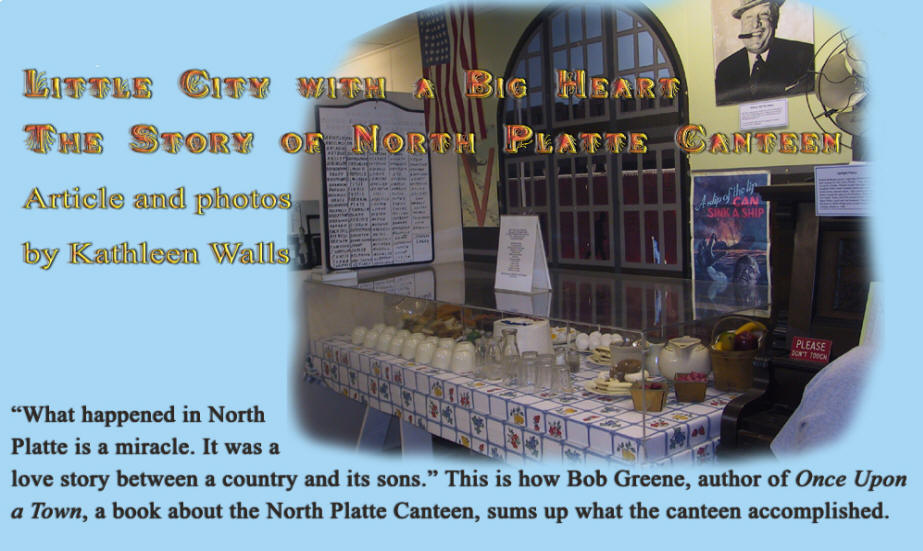
The North Platte Canteen is one of America's little known
World War II stories. I first heard of it on a recent visit to
North Platte. You
know you are going to have an authentic experience when you
enter the museum through three doors that are preserved from the
original North Platte Canteen. Inside, we were greeted
by James Griffin, the museum curator.
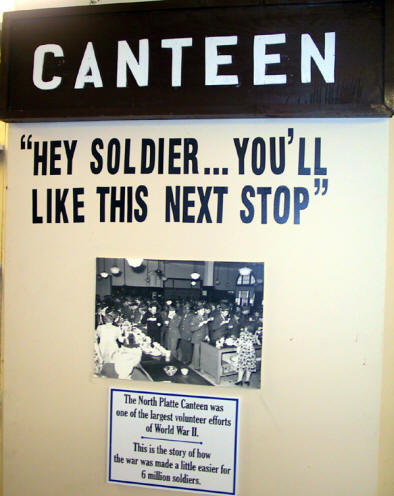 |
| One of the original canteen
signs |
James told us the story of the canteen and how it began.
"The canteen began unofficially on Dec 17, 1941 because
the people heard that their
local Company D of Nebraska National Guard was coming and
they wanted to give them their Christmas gifts . Instead it was
the Kansas National Guard on that train. Someone stepped forward
and said they wanted to give their gifts. Then they all stepped
forward.
"From that was born the Canteen. The next
day, Rae Wilson wrote a letter to the newspaper saying that we
should have one here since there wasn't any war industry here
they ought to make raising moral their war industry. So on
Christmas Day 1941 the official canteen gave its first meal.
From then on until April 1,, 1946, no troop train was
missed. Now, that's not a small feet because at the height of
the war a troop train was coming through ever hour on average.
They were serving up to 5,000 a day at no cost to the soldiers.
this was all done
by volunteers.
North Platte at that time was about 12,000 people. It became a
western Nebraska project. 125 communities participated."
Bill Jeffers who was president of the
railroad, offered free transport to volunteers coming to help at
the canteen. The
soldiers were thrilled to stop in North Platte. No matter their
rank or color everyone was treated exactly the same at the
canteen. It was the largest canteen in the United States.
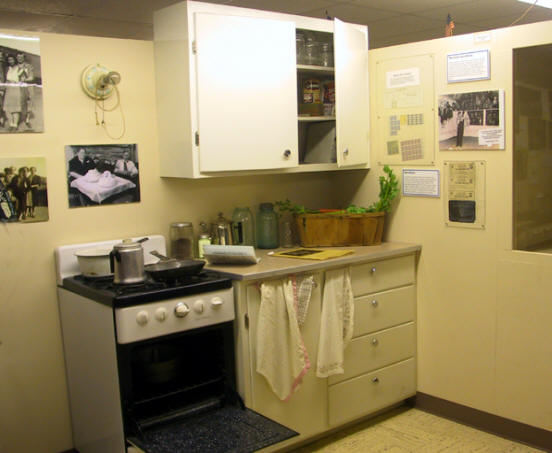 |
| Canteen kitchen |
The deep feelings of these volunteers is summed up in a
statement made by one canteen volunteer who had recently lost
her own son. "I can't help my son, but I can help someone else's
son."
The museum is in the front section of the
building and the canteen in the back. From far back in what had
been the kitchen area, a man was playing a piano. I couldn't
recognize the tune but felt it was one I had heard my own
grandmother play as a tiny child perhaps as far back as the war
years. It gave me a hint of what a lonely serviceman must have
felt when he first entered this building. My fellow journalists
and myself wandered back and viewed the many artifacts from the
days of the canteen, a huge coffee urn, a table set as it was
from 1942 to 1945, a lot of letters, pictures and stories about
the canteen. Among the weapons displayed there are a captured
Nazi flag and a battle worn American flag.
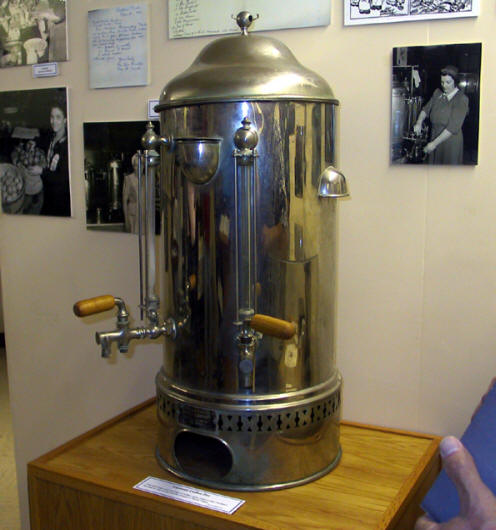 |
| Coffee urn used at the canteen |
They tell and interesting story
about popcorn balls that really piqued my interest. It was the
most unusual romance I had ever heard about. The story began
with a simple popcorn ball.
It was the habit of many of the young ladies at the
canteen to place their names and addresses inside the
popcorn balls
they passed out to the soldiers. Sometimes the soldiers
wrore and they became pen pals. In some cases it blossomed into
something more.
In 1942, Virgil Butolph was a 25 year old
serviceman passing through
the canteen.
Ethel Winters, a 19 year old girl from nearby Tryon, was helping
at the canteen that day.
Some of the Tryon women stuffed the names and addresses
of some of the local high school girls into the popcorn balls
that day. One name that went into the balls was Ethel's younger
sister, Vera. Virgil got the ball with Vera's name in it but
wasn't interested in writing anyone. He passed it on to a buddy
who did write Vera.
When Virgil saw the correspondence that
resulted, he asked the buddy if Vera had a sister. Thus Virgil
and Ethel began corresponding. Gradually the letters took on a
more serious tone.
Virgil asked for her photograph and sent her one of his. He
began sending pressed wildflowers he picked from the Aleutian
Islands where he was then stationed.
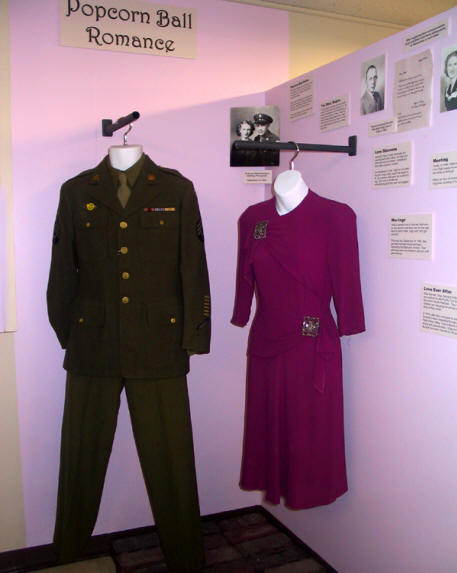 |
| Virgil and Ethel's wedding
clothes |
Virgil asked his sister to buy Ethel first a cedar hope chest.
Ethel began saving her own earnings to fill it with household
items a new home might need. Then in July 1943, Virgil asked his
sister to buy Ethel a diamond ring for him. Ethel agreed to wear
it on the condition they were not really engaged until they met
in person and got to know each other.
Finally in
the summer of 1944, Virgil got his long awaited
furlough. He sent Ethel a telegram as soon as he reached the
States but it only arrived at her home about half an hour before
Virgil himself. Needless to say,
it was love at first sight.
Virgil spent some of his furlough in
Ringgold with Ethel and then took her to nearby Kearney to meet
his parents. Returning from Kearney on Sept. 14, 1944, Virgil
said, "Let's get married."
They drove to a nearby Methodist Church
in North Platte were married that same night. They used
the church restroom to change clothes, Virgil into his uniform
and Ethel into a dress she had in the car. Virgil and Ethel had
met in person just two weeks before the ceremony.
The marriage lasted until March 21, 1976,
when Virgil had a
heart attack and died
on a trip to Hershey to see the Sandhill cranes, one of
their annual traditions. The couple had five children.
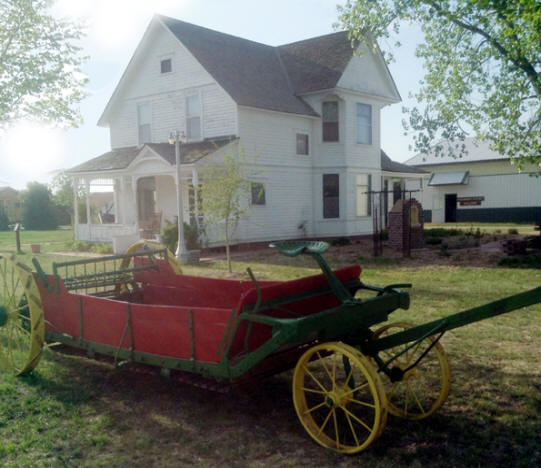 |
| Restored
farmhouse in the village |
Ethel donated Virgil's Army uniform and her
wedding dress to the Lincoln County Historical Museum
where it hangs with the
photos they exchanged, some letters and this story.
As fascinating as the Canteen part of the museum is, it's only a
small part of the exhibits. After I browsed the canteen and
front section of the museum, someone suggested we go see the
Pioneer village out
back. What a treasure we found!
Sixteen orignal buildingd that transport
you to Lincoln county's past.
We visited former Union Pacific President Bill Jeffers'
North Platte boyhood home. James
Griffin told us, "Jeffers was kicked out of school in sixth
grade for hitting a teacher. He went to work for Union Pacific
as a janitor. Worked his way to call boy and eventually became
president of the railroad."
The other home preserved in the village is
the Ericsson Home. E. E. Ericsson was the first homesteader in
Lincoln County. The two story log home is beautiful in its
simplicity.
 |
| Part of the village |
Then there was Trinity Lutheran Church. which is still used for
weddings, and
Birdwood School, typical of a Plains area one-room schoolhouse.
The tiny jail cell on display is enough to make even the
most harden criminal decide to walk the straight and narrow
here. It is just a barred iron cage with none
of the modern comforts.
Being a railroad town, naturally there is a
depot and caboose. Dick's Barber shop probably offered
passengers on layovers a much cheaper haircut and shave then you
will get in any airport shop today.
What a place to walk through the best of
American history.
For
more info:
http://www.lincolncountymuseum.org/
|